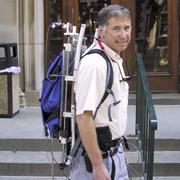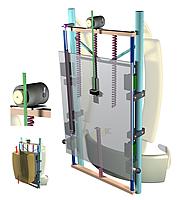 Developer Lawrence Rome hefts his energy pack.© Larry Rome
Developer Lawrence Rome hefts his energy pack.© Larry RomeHikers toiling under the weight of a heavy backpack needn't just get hot and sweaty from their efforts. Some of the energy they expend in walking can now be captured by a backpack devised by US researchers, which converts it to electricity that can power portable electronics.
The pack, which weighs about 20-38 kg depending how much power you need, generated up to 7.4 watts of power when tested on a treadmill. That's enough to keep your GPS locator and a head-lamp running indefinitely in the wilderness - potentially useful for soldiers or rescue workers. They could even take a break now and then without losing power, as surpluss energy is stored in lightweight batteries.
Walking is a particularly good source of human power: during steady hiking the muscles produce up to 100 W. As far back as 1967, scientists at the Massachusetts Institute of Technology used piezoelectric devices, which generate electricity when squeezed, inserted into the heel of a shoe to create power for portable electronics such as pacemakers. But mechanical generators housed in shoe heels have tended to be rather cumbersome and fragile. (Click here to see other ways that inventors have harnessed human energy.)
Biologist Lawrence Rome of the University of Pennsylvania in Philadelphia, a specialist in animal locomotion, and his co-workers had the bright idea of harnessing power from the vertical motion of a walker's hips.
Spring in your step
 The pack sits on sliding rails, to harness the up and down movement of your hips.© Science
The pack sits on sliding rails, to harness the up and down movement of your hips.© ScienceThe backpack is spring-loaded, so it can bounce up and down when the wearer walks. This moves a toothed rod, which meshes with a gearwheel. As the gearwheel rotates, it generates electricity.
The heavier the load, the more power the pack generates. But the researchers were concerned that the shifting load might force the wearer to use more energy in walking, much as a bicycle dynamo puts a greater strain on a cyclist. So they measured the metabolic rates of their test subjects by looking at how much oxygen they consume.
To their surprise, they found that the extra energy needed, relative to a fixed pack, was far less than predicted. It seems that the wearers changed their gait to walk more efficiently when wearing the sliding pack, the researchers report in Science1.
Free ride
ADVERTISEMENT
This doesn't come as a shock to Andy Ruina of Cornell University in Ithaca, New York, a specialist in the mechanics of walking. He has shown in theory how systems of masses and springs attached to a human body can reduce the energy cost of walking. It seems that Rome and colleagues have hit on a similar arrangement. "There is probably room for improvement both in getting more electricity out and in decreasing the metabolic cost," says Ruina. Perhaps that could one day make it light enough for use by casual backpackers.
Such improvements might be made as the pack is developed for commercialization by a spin-off company in Pennsylvania called Lightning Packs. "One could then generate electricity while carrying a load more economically and with greater comfort than with a conventional backpack," says mechanical engineer Arthur Kuo of the University of Michigan. It would be almost like getting energy for free.
